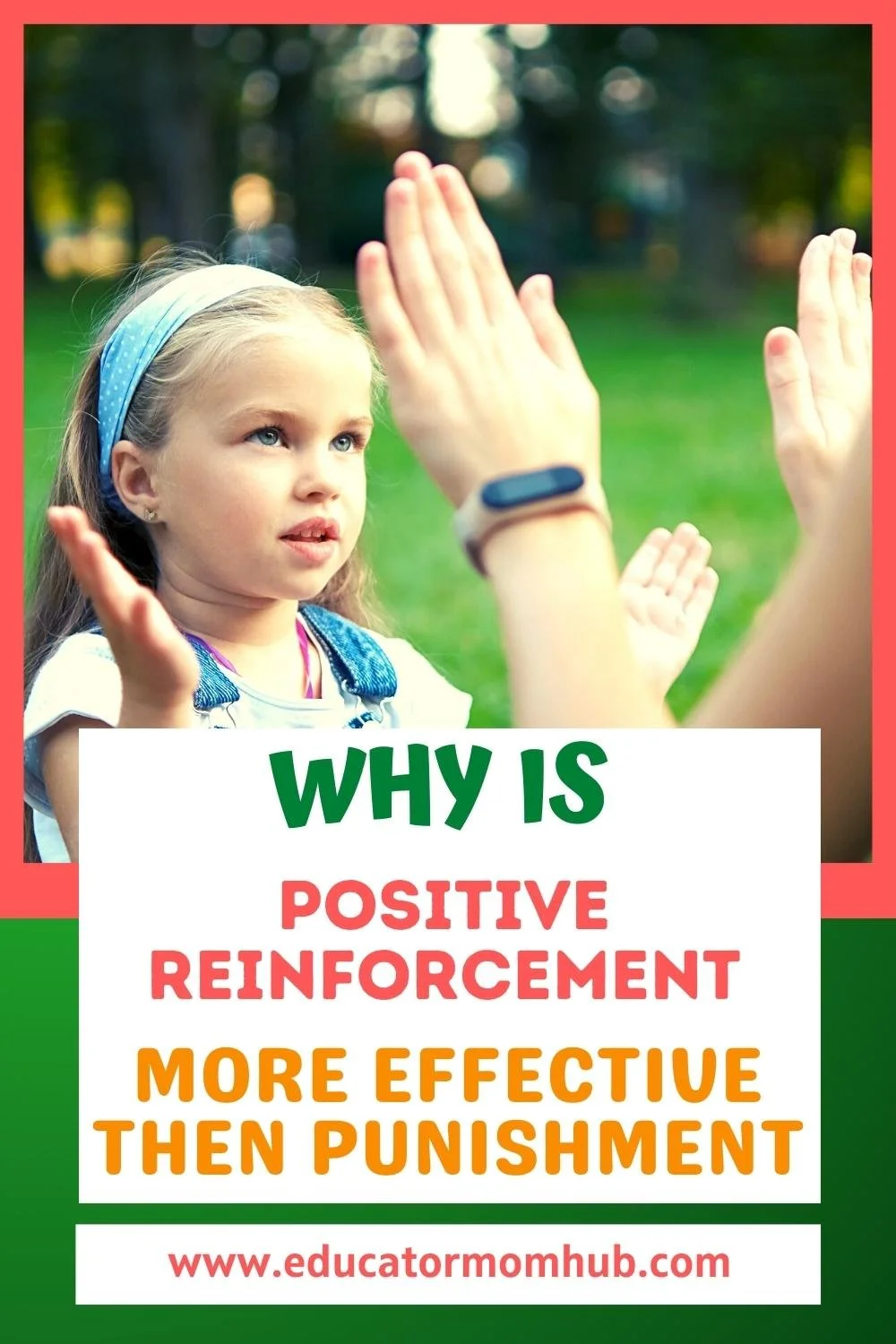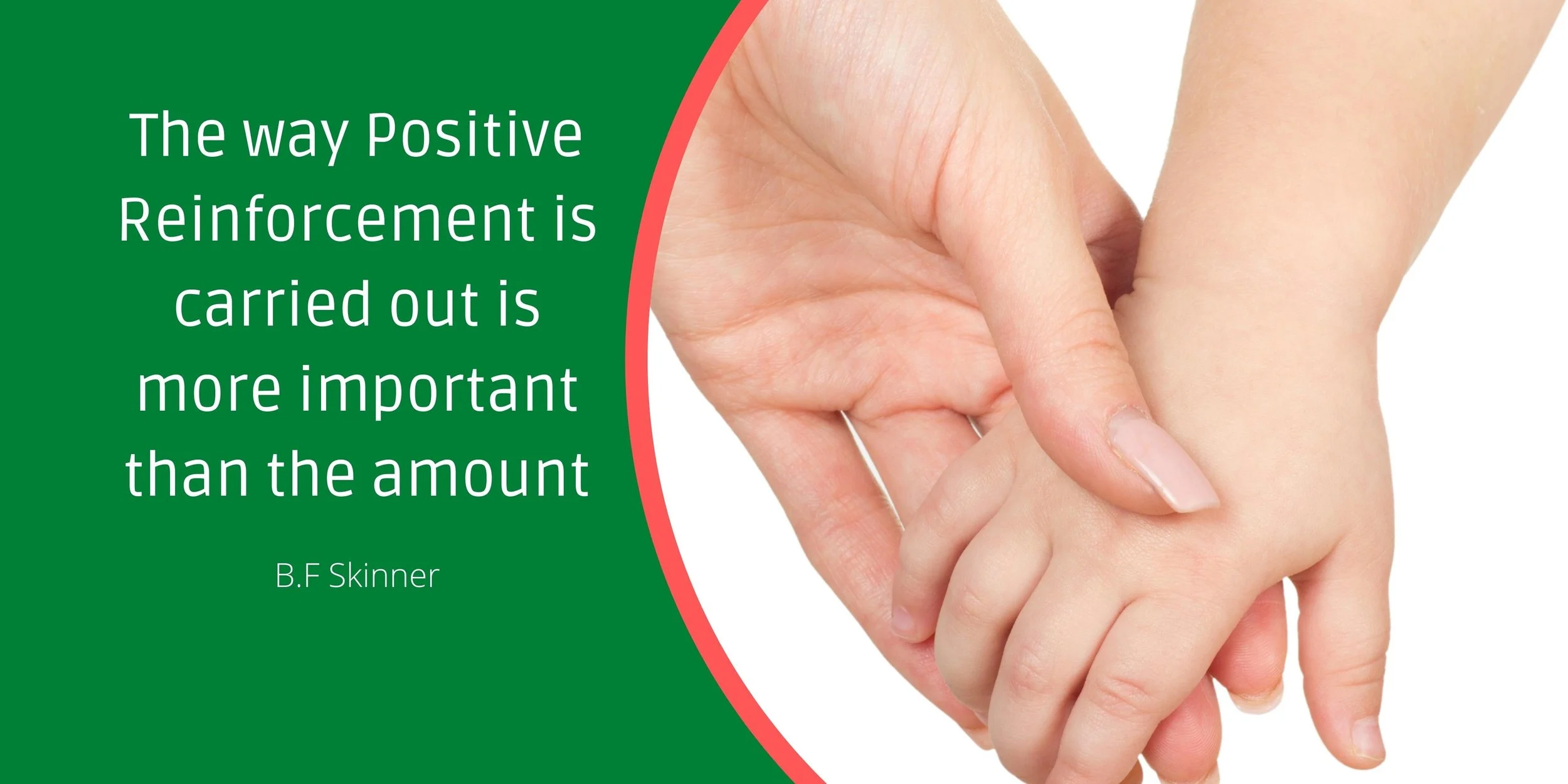How to Use Positive Reinforcement for Better-Behaved Kids
Positive reinforcement is one of the most powerful tools parents have in their toolbox to encourage good behavior in their children.
It can be used to shape children's learning and help them develop positive habits.
When used correctly, positive reinforcement can be a very effective parenting tool.
In this blog post, we will discuss what positive reinforcement is, how it works, and some practical ways to use it in your home!
What Is Positive Reinforcement?
Positive reinforcement is a technique that rewards desirable behavior to increase the likelihood of that behavior being repeated.
It is one of the most common strategies used for positive parenting, because positive reinforcement works!
Positive Reinforcement Vs Negative Reinforcement
Positive reinforcement is a reinforcing stimulus that rewards a child for desired behavior.
This could be something as simple as verbal praise or a hug, or it could be a tangible reward like a sticker or a treat.
The goal of positive reinforcement is to encourage the child to repeat the desired behavior or to learn a new behavior.
Negative reinforcement, on the other hand, involves taking something away after a child exhibits negative behavior.
For example, if a child throws a tantrum, the parent may remove the child from the situation or take away a toy.
The goal of negative reinforcement is to stop the child from engaging in unwanted behavior.
So, which type of reinforcement is best for kids?
The answer may depend on the individual child, but some studies suggest that positive reinforcement is more effective in promoting long-term change.
Why is Positive Reinforcement More Effective than Punishment?
While positive reinforcement promotes the likelihood of that behavior being repeated, Punishment, on the other hand, is a type of discipline that involves inflicting pain or discomfort as a means to stop bad behavior.
Although punishment may work in the short term, it can often have negative consequences such as causing resentment, fear, and anger in the person being punished.
Additionally, punishment does not teach the individual how to behave properly, whereas positive reinforcement does.
Why is Positive Reinforcement Important for Kids?
It's no secret that children respond to positive attention.
Who doesn't feel good when they're told they've done a great job?
That's because recognition is a form of positive reinforcement.
When we receive positive reinforcement, it encourages us to keep up the good work.
For kids, this can be a powerful motivator.
In addition to making them feel good, positive reinforcement also helps kids learn new skills and positive behaviors.
When they're praised for a specific behavior, they're more likely to repeat that desired behavior.
On the other hand, if they're constantly scolded or punished, they may start to feel hopeless and give up.
With positive reinforcement, however, kids can learn that their efforts are valued and that they have the power to make choices that will lead to a positive outcome.
In short, positive reinforcement is an important tool for helping kids reach their full potential.
How to Use Positive Reinforcement for Better Behaved Kids
One of the best ways to encourage good behavior in children is to create an environment that supports it.
This means setting clear expectations and rules.
Setting Clear Expectations
Parents need to set clear expectations for their children's behavior.
When kids know what is expected of them, they are more likely to meet your expectations.
Visual representation of rules works better for children. this can be in a form of a daily routine chart or expected behavior charts.
In the article- How To Manage Children's Behaviour With Daily Routine Charts- you can download a FREE Routine Chart Template.
You can also download a FREE Expected Behavior Chart from Here-How to Set Limits for Kids- 9 Tips for Behavior Management
Positive Reinforcement
And when they do meet your expectations, it's important to reinforce their good behavior with positive reinforcement.
Positive reinforcement can take many forms, but some of the most effective methods include praise, awards, and privileges.
By taking the time to consistently reinforce your children's good behavior, you can help them develop into well-behaved, responsible children.
Verbal Praise
When parents or teachers take the time to point out what a child is doing right, it helps the child feel good about herself and encourages her to continue behaving positively.
Verbal praise can be given in the form of a simple compliment, such as "good job!" or "you're doing so well!" It can also be delivered in a more specific way, such as praising a child for following directions or completing a task.
In addition to increasing desirable behavior, verbal praise can also help to build self-esteem and confidence.
As a result, it is an important tool for parents and teachers to use when working with children.
Here is a helpful article: How to Praise Your Child The Right Way- 65 Examples
Tangible Rewards
Rewards can be a great way to encourage positive behavior in children. When used correctly, rewards can help children learn new skills, stay on task, and make desired changes in their behavior.
The key to using rewards effectively is to make sure that they are given consistently and that they are meaningful to the child.
For example, using a sticker chart to motivate a young child who is potty training to use the toilet.
It's important to avoid using rewards as bribes or threats.
For example, promising a child a toy if he cleans his room is a bribe or threatening to take away privileges if he doesn't do his homework is a form of threat.
Instead, focus on using them as a way to praise desired behavior.
For example, give your child a sticker after he cleans his room or an extra half hour of screen time if he finishes his homework.
When used correctly, rewards can be a powerful tool for shaping positive behavior in children.
Privileges
Privileges are a great way to reinforce positive behavior in children.
By allowing them to access certain activities or items that they enjoy, you can encourage them to continue behaving in an acceptable way.
Of course, it is important to be consistent with privileges and to make sure that they are only given for good behavior.
Otherwise, children may come to expect privileges regardless of their actions. It is also important to consider the age of the child when deciding which privileges to offer.
When used consistently, privileges can be a great way to help children learn to make good choices and develop healthy habits.
Physical Affection
Physical affection is a powerful tool that can be used to positively reinforce good behavior in children.
When children behave in ways that we approve of, we can show our approval through physical affection.
This can be something as simple as a hug or a pat on the back.
By doing this, we are sending the message to the child that their behavior is something that we value and want to encourage.
Physical affection is a great way to reinforce good behavior because it is immediate, non-verbal, and universally understood.
It is also highly effective in boosting self-esteem and fostering positive emotional bonds.
So next time your child does something that you want to encourage, reach out and give them a big hug!
Mistakes to Avoid When Using Positive Reinforcement With Young Kids
Now that we've gone over some of the ways that you can use positive reinforcement to encourage good behavior in children, let's take a look at some of the mistakes that you should avoid.
Focusing Too Much on Rewards and Not Enough on the Child's Natural Curiosity and Desire to Learn.
It's important to give children rewards for the desired action, but it's also important to remember that they're naturally curious and want to learn new things.
If you focus too much on rewards, you may end up missing out on opportunities to teach and guide them.
Instead, focus on using rewards as a way to praise desired behavior while also taking the time to teach children why that behavior is important.
For example, if your child is potty training, give him a sticker after he uses the toilet. But also take the time to explain to him why it's important to use the toilet and how it will help him stay healthy.
2.Using Rewards That Are Not Age-Appropriate or Are Too Expensive.
Using rewards that are not appropriate for the child's age can be ineffective.
Also, using rewards that are too expensive may not be practical. It's important to find a balance between using rewards that are motivating but also affordable and age-appropriate.
For example, younger children may be motivated by simple things like stickers or extra screen time.
Older kids may need more substantial rewards, such as being able to choose the activity for a family fun night or staying up an extra half hour on Fridays.
3.Rewarding Children for Things They Should be Doing Anyway
Some rewards are given for things that we should do anyway, like showering and brushing our teeth.
While it's important to encourage children to do these things, it's also important to remember that they should already be doing them.
So, instead of rewarding children for things they should be doing anyway, focus on rewarding them for things that are above and beyond what is expected.
For example, if your child goes above and beyond in their schoolwork or helps out around the house without being asked, that is something worthy of praise and a reward.
4. Not Being Consistent
It's important to be consistent when using positive reinforcement.
This means rewarding the desired behavior every time the expected behavior occurs. If you only reward sometimes, children will quickly learn that they only need to behave well when there is a reward involved.
To ensure consistency, it can be helpful to set up reward systems, such as a sticker chart.
This way, children know exactly what they need to do to earn a reward and they can see their progress over time.
5. Becoming Overly Dependent on Rewards
Using rewards too much can be a bad thing.
It can make you forget to praise your children for the good things that they do.
It's important to use positive reinforcement as part of a healthy parenting style. This means using it as one tool in your toolbox, not the only tool.
So, make sure to use positive reinforcement in moderation.
Remember to also praise your children verbally for their good behavior and take the time to teach them why that behavior is important.
Verbal praise is just as important as rewards when it comes to encouraging good behavior.
6. Not Being Specific
When praising children for their behavior, it's important to be specific.
For example, instead of saying "good job," say "great job on brushing your teeth!"
This way, children know exactly what they did that was good and they are more likely to repeat the behavior in the future.
Praising specific behavior also allows you to focus on the positive behavior, rather than the negative behavior.
For example, if your child hits his sister, instead of saying "don't hit," you could say "I like how you used your words to ask her to move."
This way, you're focusing on the desired behavior (using words) rather than the undesired behavior (hitting).
7. Not Being Timely
It's important to give positive feedback for your child's efforts as soon as possible.
This way, they know that they did something good and they are more likely to repeat the behavior in the future.
So, if your child cleans up his toys without being asked, make sure to praise him right away.
The same goes for any other desired behavior. The sooner you praise, the more effective it will be.
8. Offering Too Many Choices
When using positive reinforcement, it's important to offer choices that are appropriate for the child's age and development.
For example, younger children may not be able to handle too many choices.
It's also important to make sure that the choices are things that you're comfortable with.
For example, if you don't want your child to have candy as a reward, don't offer it as a choice.
Instead, focus on offering choices that are healthy and helpful, such as a special play date or choosing what to have for dinner.
By offering choices that are beneficial, you can help children learn how to make good decisions in everyday life.
9. Not Being Creative
There are many different ways to use positive reinforcement. It's important to be creative to keep children interested and motivated.
For example, you could create a rewards system that allows children to earn points for good behavior.
They can then use those points to buy things from a "store" or redeem them for special privileges.
You could also get creative with the rewards themselves.
For example, instead of offering candy or toys, you could offer experiences, such as a special outing or an extra half hour of playtime.
The possibilities are endless, so get creative and have fun!
Conclusion
There are many different ways to reinforce positive behavior in children.
The key is to find what works best for your child and to be consistent with your approach.
With a little trial and error, you will soon find an approach that works well for you and your family.
FAQ
Q: What is positive reinforcement in early childhood?
A: Positive reinforcement is a parenting technique that involves praising or rewarding children for desired behavior. The goal of positive reinforcement is to increase desirable behavior and shape children's learning.
Q: How does positive reinforcement shape children's learning?
A: Positive reinforcement helps children learn new skills and develop desired habits by providing rewards for good behavior. This encourages children to continue behaving in an acceptable way.
Q: How can I use positive reinforcement to discipline my kids?
A: When used correctly, positive reinforcement can be a powerful tool for disciplining kids. Some practical ways to use positive reinforcement include offering privileges and physical affection as rewards for good behavior. It is important to be consistent with your approach and to find what works best for your family.
Q: What are some common mistakes parents make with positive reinforcement?
A: Some common mistakes parents make with positive reinforcement include using rewards as bribes or threats, being inconsistent with rewards, and not considering the child's age when choosing rewards. It is important to use positive reinforcement in a way that encourages desired behavior without accidentally encouraging undesired behavior.












